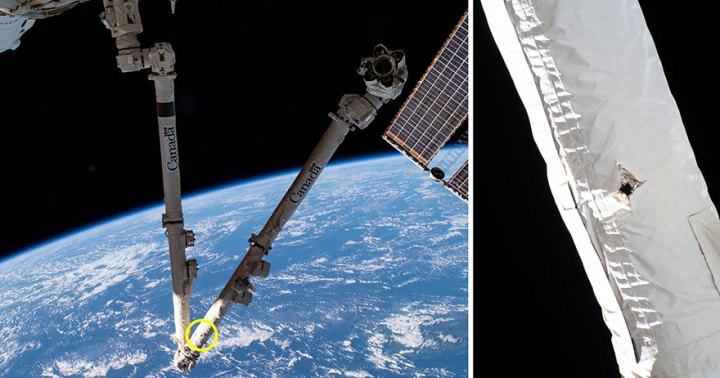
The threat posed by orbital debris to operational satellites has hit the headlines again after it emerged that a piece of space junk recently slammed into the International Space Station’s Canadarm2 robotic arm.
The incident occurred several weeks ago but has only just come to light. The crew aboard the ISS were all inside the main module at the time, but it was clearly a close call for the space station.
Discussing the incident in an online article, the Canadian Space Agency (CSA), which oversees the operation of Canadarm2, posted a photo (top) showing a clear hole in the arm but said the damage appeared to be minor.
“Despite the impact, results of the ongoing analysis indicate that the arm’s performance remains unaffected,” the CSA said. “The damage is limited to a small section of the arm boom and thermal blanket.”
It added that the arm remains able to perform its planned operations, though both NASA and CSA will continue to gather data to conclude the analysis.
The Canadarm2 robotic arm was fitted to the ISS in 2001 and assists in modification and maintenance work on the orbiting outpost. It’s also used to “catch” visiting uncrewed spacecraft.
Gilles Leclerc, director general of the Canadian Space Agency, described the recent incident as a “lucky strike,” suggesting that such a hit could have resulted in far more serious damage to the robotic arm, or indeed the space station itself.
In a tweet, Leclerc added, “Seriously, this shows the threat of orbital debris as much as robust Canadarm2 engineering with 20 years of intense space station operations.”
Recent NASA data suggests there are at least 26,000 pieces of debris “the size of a softball or larger that could destroy a satellite on impact; over 500,000 the size of a marble big enough to cause damage to spacecraft or satellites; and over 100 million the size of a grain of salt that could puncture a spacesuit.” Such material can travel at speeds of up to 15,000 mph, causing potentially serious problems for anything that gets in its way.
Near-Earth space debris is a growing problem for spaceflight companies, though of course they’re also part of the problem. With small-satellite deployment on the rise, more junk will form when a satellite malfunctions or is decommissioned, with the metal contraptions entering a potentially endless orbit. And if they hit another satellite or piece of junk, the result will be thousands of new pieces of hazardous material.
A number of organizations around the world, including NASA, track space debris. If dangerous material is spotted in time, instructions can be issued to move any nearby operational satellites out of its path. Various companies are also working to develop systems to clear near-Earth orbit of the dangerous junk.
Editors' Recommendations
- Junk from the ISS fell on a house in the U.S., NASA confirms
- 25 amazing ISS photos to mark 25 years of the space station
- 10 space station questions answered on its 25th anniversary
- Spot the space station with this new NASA app
- Space station leak prompts NASA to rework spacewalk schedule


